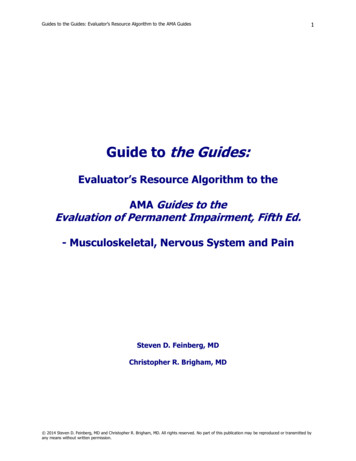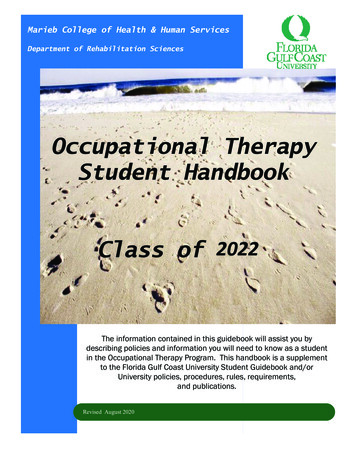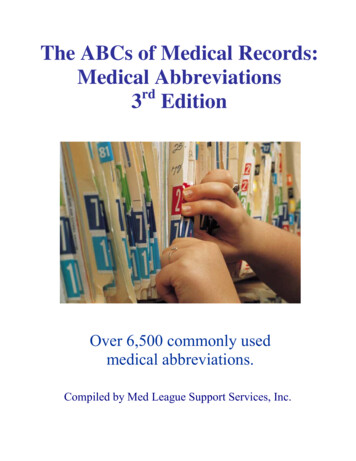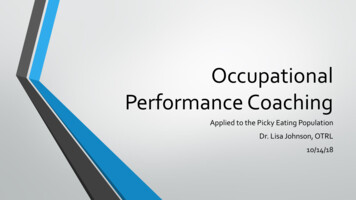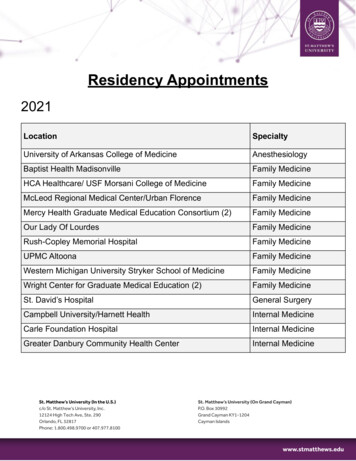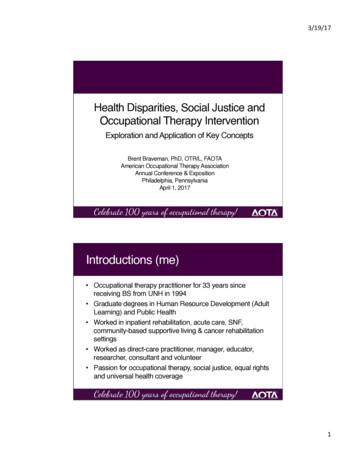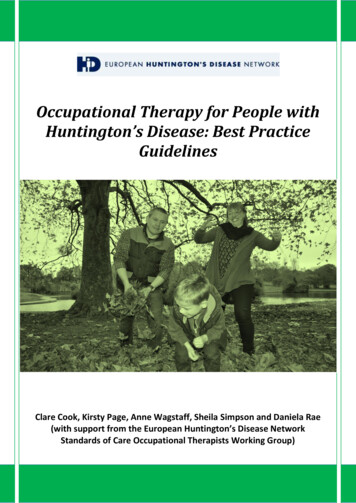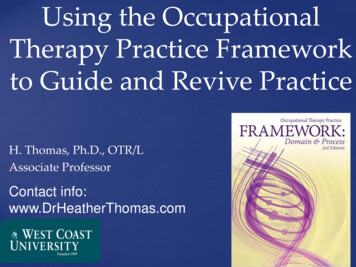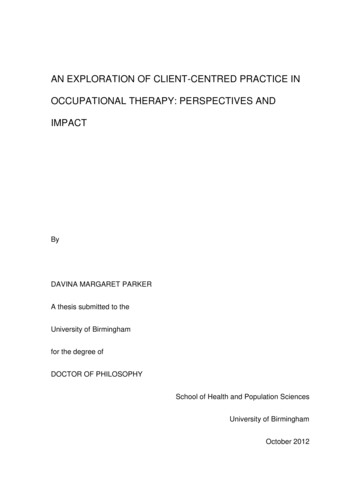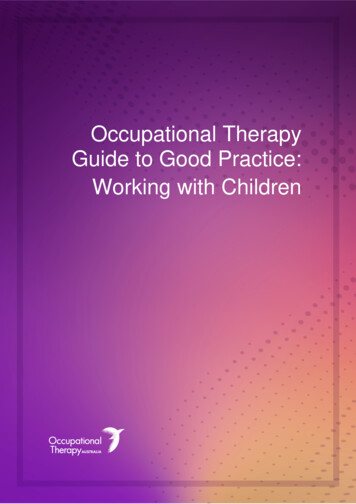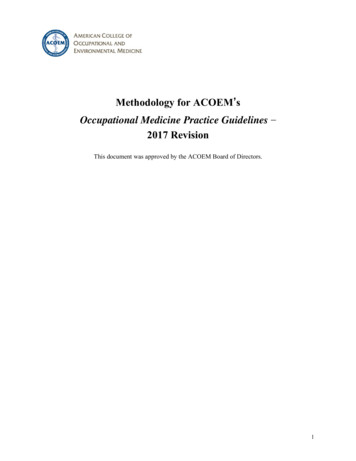
Transcription
Methodology for ACOEMʼsOccupational Medicine Practice Guidelines ‒2017 RevisionThis document was approved by the ACOEM Board of Directors.1
Table of ContentsPageI.Introduction4II.Purpose and ScopeA. Purpose4B.Scope4C.Patient Population5D. Target AudienceIII.IV.5Organizational StructureA. Evidence-based Practice Committee (EBPC)B. Research Team(s)566C. Evidence-based Practice Panels (EBPPs)D. Guideline Methodology Committee66Process for Development of Guidelines and Evidence-based ProductsBackground and Introduction7A. Oversight by Editor and Evidence-based Practice Committee7B.Prioritization of Topics for Review and Recommendation7C.Review and Formulation of Recommendations by the EBPPs Literature Evaluation: Literature Search and Study Selection Literature Evaluation: Critical Review of Studies779 Development of Guidelines and Recommendation Statements9D. External Peer Review12E.Stakeholder Input13F.Pilot Testing13G. Review by the GMC and ACOEM Board of Directors13V.Updating Process13VI.Applicability/Tools for Putting it Into PracticeA. MDGuidelines B. Monitoring/Auditing Criteria1313TablesTable A: Criteria for Accepting Studies as Containing Adequate Evidence(Study Inclusion Criteria)A-1: Criteria for Adequate Evidence for Studies of Clinical2
Assessment Methods14A-2: Criteria for Adequate Evidence for Studies of ClinicalTreatment Methods15Table B: Quality Scoring of Treatment StudiesTable C: Quality Scoring for Diagnostic Studies1619Table D: Strength of Evidence Ratings20Table E:Evidence-based Recommendations21Table F:Characteristics of ACOEM Evidence-based Recommendations22AttachmentsDeveloping Guideline Scope and Formulating Clinical QuestionsAttachment 1: Clinical Questions in the Key Domains of Occupational Medicine PracticeAttachment 2: Problem Formulation Example2324Guidelines Development Committees and PanelsAttachment 3: Procedures for Selection and Training of Guidelines DevelopmentGroups PanelAttachment 4: ACOEM Evidence-based Practice Committee Appointments:Application Form25Attachment 5: Member Confidentiality Agreement/Statement of DisclosuresAttachment 6: Training Curriculum2832Literature Evaluation Processes/Developing RecommendationsAttachment 7: Evidence Ranking by Type of Clinical Question34Attachment 8: Diagnostic Summaries37Attachment 9: Example of Search Criteria Table42Attachment 10: Databases to be Searched44Attachment 11: Sample Evidence TableAttachment 12: Sample Voting Process4547Attachment 13: ACOEM Guideline Development/Revision Process SummaryAttachment 14: External Peer Review ProcessAttachment 15: Professional and Patient Organizations to be Invited to ReviewUpdates to the GuidelinesAttachment 16: Stakeholder/Patient InvolvementAttachment 17: Monitoring/Auditing Criteria4850515354References57AppendicesAppendix 1: Methods by which ACOEM Adheres to the AGREE II CriteriaAppendix 2: Methods by which ACOEM Adheres to the AMSTAR CriteriaAppendix 3: Methods by which ACOEM Adheres to the GRADE CriteriaAppendix 4: Methods by which ACOEM Adheres to the IOM Criteria59636569263
I. IntroductionThe American College of Occupational and Environmental Medicine (ACOEM) first published itsOccupational Medicine Practice Guidelines (Guidelines) for common health disorders of workers in1997.(1) In 2004, ACOEM released the second edition of the Guidelines, based on an updated search andevaluation of the literature.(2) The methodology used for those editions was described in the introductionto each volume, and in other publications.(3, 4)In early 2006, the President of ACOEM announced a schedule to produce updates of the Guidelines, andthe formation of an updated Guideline development structure, including the Evidence-Based PracticeCommittee (EBPC), the Guideline Methodology Committee (GMC), and Evidence-Based Practice Panels(EBPPs). The GMC was asked to update and describe in depth the methodology to be used for allACOEM evidence-based products and services. That document was approved by the ACOEM Board ofDirectors on November 13, 2006 and published in 2008.(5)In 2007, the first guideline using the updated methodology was published. Many additional guidelineswere produced over the next several years.(6, 7) In 2011, the entire second edition had been updated andpublished as the third edition of the Guidelines.(6) Subsequently, there were additional advances in thescience of developing quality Guidelines, and a new document from the Institute of Medicine (ClinicalPractice Guidelines We Can Trust(8)) was published. The present ACOEM Guidelines Methodologydocument has been updated to include these and other advances in guidelines development. Summarycharts comparing ACOEM’s methodology to the standards set in AGREE II, AMSTAR, GRADE, andIOM are available in Appendices 1-4.II. Purpose and Scope(9)A. PurposeThe purpose of the Guidelines is to define evidence-based best practices for key areas of occupationalmedical care and disability management in order to: Improve the efficiency and accuracy with which the diagnostic process is conducted; Identify the effectiveness and risks of individual treatments and treatment plans in resolving a diseaseprocess, structural pathology, or relieving symptoms and achieving functional improvement andreturn to work; Improve or restore the health of workers with occupationally related illnesses or injuries by usingproven effective tests and treatments with net benefit; Improve the quality of occupational medical care and disability management; and Enhance patient autonomy.(10)B. ScopeThe Guidelines address the key domains of occupational medicine practice including: Diagnosing health problems likely to be work-related;Determining work-relatedness individually and collectively;Managing medical care;Treating work-related health problems efficiently and effectively;Managing associated disability and work loss;Preventing work-related health problems; andPromoting health.Examples of the broad clinical questions(9) that the Guidelines may address in these areas are listed inAttachment 1.4
The First through Third Editions of the Guidelines consisted of two parts – “Foundations of OccupationalMedicine Practice” and “Disorders.” “Foundations” reviewed prevention; initial assessment anddocumentation; initial approaches to treatment; work-relatedness; disability prevention/management;pain, suffering, and restoration of function; and independent medical exams/consultations. “Disorders”included complaints related to the neck and upper back; shoulder; elbow; forearm, wrist, and hand; lowback; knee; ankle and foot; eye; and stress-related conditions.i Section I (“Foundations”) is updated byidentifying questions that should be addressed regarding best practices for general management of clinicalconditions, disability, and medico-legal matters. Section II (“Disorders”) is both expanded (based onadvancements in diagnosis and/or treatment) and updated by identifying new clinical questions to addressfor each clinical entity or diagnostic group. Questions are framed in PICO format(11) (population ofinterest, intervention, comparison group, and outcome). The questions for etiology, diagnosis, andprognosis are framed in a modified PICO format, emphasizing such factors as specific exposures ortrauma for etiology or prevention, natural history for prognosis, and the reproducibility and performanceof diagnostic tests accepted reference standards for clinical assessment. (See Attachment 2 for criteriaconsidered when developing the questions to address for the updates to the Guidelines.)C. Patient Population(9)The Guidelines apply to working age adults with medical conditions related to work or that affect theability to work. In general, the age range under consideration had been 18 to 65. However, many workersare now older than 65, so some guidance has been expanded to include all workers. As a practical matter,many studies include older adults. Those studies are incorporated in the evidence-base for considerationunless there is a clear rationale for exclusion (e.g., highly unlikely to apply to a working age population).Such exclusions are rare. Thus, while the ACOEM guidelines are targeted towards working age adults,the evidence used may include the general adult population, resulting in guidelines that likely havesubstantially wider applicability than the target population.D. Target Audience(9)The target users of the Guidelines are: Physicians and other health care providers;Healthcare organizations;Patients and consumers;Clinical case managers;Insurers and third party administrators;Insurance claims managers and utilization reviewers;Attorneys and judges;Workers’ compensation regulators and policy makers; andAll others with responsibility for or involvement in worker health, safety and productivity andworkers’ compensation systems.III. Organizational Structure(9)The ACOEM Board of Directors has approved the following organizational structure and methods for thedevelopment of recommendations for evidence-based practice contained in this update. The Board alsohas the opportunity to review and comment on all evidence-based guidelines prior to publication.Comments from the Board are reviewed in the same way as external review comments. However, in orderto maintain editorial independence, the Board does not officially approve the Guidelines. Below are thefunction, responsibility, and objective (FRO) statements for the committees and panels involved withACOEM’s Guideline-related activities (see Attachment 3 for a detailed description of the selection andtraining of Guidelines development groups described below).iAdditionaltopics many be included in the update of the Guidelines.5
A. Evidence-based Practice Committee (EBPC)The EBPC is comprised of the chairs of each of the Panels. Meetings may be attended by others whohave been involved with previous ACOEM Guideline activities (e.g., panel members and similarindividuals). The EBPC is charged with coordinating the updates of the ACOEM evidence-basedpractice Guidelines. The EBPC:1. Assists with determining the priority of individual guidelines and advises regarding the timetablefor review of guideline topics.2. Assists with identification of additional guideline topics and clinical questions to be considered inthe Guidelines.B. Research Team(s)Trained research teams:1. Draft preliminary clinical questions in PICO format for each guideline.2. Develop and document search strategies and methods for each guideline topic.3. Conduct systematic literature searches for each guideline topic.4. Summarize studies in evidence tables.5. Critically appraise, grade and critique each study.6. Draft background text, rationale statements, and recommendations for each guideline topic.C. Evidence-based Practice Panels (EBPPs or “Panels”)Multidisciplinary panels are appointed and trained to develop or update evidence-based practicerecommendations. Separate panels are appointed for each body part, system, or skill area covered bythe Guidelines.ii The Panels:1. Discuss and approve draft clinical questions to frame the literature search2. Review critical analyses of the literature based on this approved methodology.3. Develop, review and approve or update evidence-based recommendations for clinical practice,care management, and disability management.Panels are often subdivided into areas of practice or research interest at the discretion of the PanelChair in discussion with the Editor-in-Chief (e.g., medical management, other therapies, tests, harms,screening) particularly when the Panel has a large scope of work (e.g., low back pain or chronic pain).D. Guideline Methodology Committee (GMC)The GMC establishes the methodology and quality review process for the development and revision ofthe Guidelines and all evidence-based products and services produced or endorsed by ACOEM. TheGMC:1. Develops the methodology for the development and revision of the Guidelines and other evidencebased products.2. Refines, clarifies, and updates the methodology based on state-of-the-art, internationally acceptedmethods.3. Ensures adherence to these state-of-the-art methods by assigning methodologists to each panel.4. Approves Panel members after reviewing applications, curriculum vitae, and conflict of interest(COI) information of individuals interested in participating on one of the Panels.5. Trains Panels in this methodology and the guideline development process.6. Publishes documents that describe and explain the methodology used for ACOEM evidencebased materials and products.(5)7. Works with ACOEM’s Education department to assure consideration and evaluation of evidencein ACOEM educational offerings.iiCurrently, these areas are asthma, interstitial lung disease, low back, neck, hand/wrist/forearm, elbow, shoulder, hip/groin, knee,foot/ankle, eye, chronic pain, opioids, traumatic brain injury, and disability prevention/management.6
IV. Process for Development and Revision of the Guidelines and Other ACOEM Evidence-basedProductsBackground and IntroductionThe process for development of ACOEM Guidelines and evidence-based products was developed bythe GMC and includes participation of the EBPC, review and formulation of recommendations by thePanels, stakeholder input, external peer review, and review by the ACOEM Board of Directors.Members of the Guideline development groups are selected from applications of ACOEM membersand nominees from relevant interest groups and professional organizations. All panel members arerequired to complete an application and an online questionnaire to: i) outline qualifications andinterests; ii) disclose potential conflicts of interest; and iii) indicate their willingness to adhere toconfidentiality procedures (see Attachments 4 and 5). Summaries of disclosures for all panelmembers are made available online. All members of the Guideline development groups are requiredto complete training in ACOEM’s evidence-based medicine methodology.(5) For further discussion ofthe selection of participants in the Guideline development groups and the training in the ACOEMmethodology, see Attachments 3 and 6.A. Oversight by the Editor and Evidence-based Practice Committee (EBPC)The Board of Directors appoints one physician to chair the entire updating process and act as Editorin-Chief of the Guideline. This physician also serves as chair of the EBPC.B. Prioritization of Topics for Review and RecommendationTo identify and guide the work of the Panel for each topic or disorder or body system, the Editor-inChief and the Research Team, in collaboration with the EBPC, and the chair of each of the Panels,works with the panels to identify clinical questions about important, useful, common, expensive,controversial or questionable work-related diagnoses, tests and procedures. Topics may also beforwarded from Panel members, peer reviewers, Board members, external stakeholders and others. Thefollowing procedures are followed:1. The Research Team identifies the most common occupational health problems, tests andtreatments in terms of frequency, cost, time off work, apparent benefits, apparent harms, andrapid increases in utilization.iii2. Diagnoses are grouped into homogeneous diagnostic groups. Tests and treatments are identifiedas groups, if similar or synonymous, or individually if the criteria for use and evidence ofeffectiveness are likely to be relatively unique.3. Panels solicit suggestions on areas to include/examine, including identification of commonlyused, and/or emerging diagnoses, work linkages, and commonly used (but not necessarily safe oreffective) tests, medications or procedures from Panel members and other stakeholders.4. The PICO questions are finalized for a given guideline by the Expert Panel.C. Review and Formulation of Recommendations by the Evidence-based Practice PanelsThe Panels, with assistance from the Research Team, formulate recommendations for guidelines inthe following manner:1. Literature Evaluation: Literature Search and Study Selection(9)The Research Team conduct systematic literature reviews for each guideline topic assigned. In orderto identify all high- and moderate-quality original research studies, the literature search is broad andcomprehensive. Medical Subject Heading (MeSH) Terms are used to identify studies relevant to thetests, treatments and diagnoses in question. A combination of MeSH terms and other terms are usedin order to determine the method that will yield the most relevant studies in the search process.iiiAt present, diagnosis- and procedure-specific data are available from workers’ compensation claims. Representative data maybe available from large workers’ compensation carriers, large self-insured employers, or existing research organizations thataggregate insurance claim data such as the Workers’ Compensation Research Institute or the California Workers’ CompensationInstitute.7
Treatment-related study searchesFor treatment-related study searches, randomized controlled trials (RCTs), and randomized crossovertrials, quality guidelines, meta-analyses and systematic reviews are the primary foci of theseexhaustive literature searches. Prospective and retrospective cohort studies are searched if there areno RCTs and systematic reviews identified. High-quality guidelines, meta-analyses and systematicreviews are sought primarily for verification of search completeness; they are independently assessedfor reproducibility of conclusions.RCTs and randomized crossover trials are all selected for critical appraisal and quality grading (seeAttachment 7). For evidence of harms, case reports, case series, retrospective cohort studies, and armsof RCTs are sought. For risk factor assessments, prospective and retrospective cohort studies arepreferentially sought, with case control or cross sectional studies selected where cohort studies areabsent. In some cases, studies with lower grades of evidence may be selected to examine currentpractice patterns or for other reasons. In order to ensure that all relevant, higher-quality studies areidentified, researchers also perform hand searches of reference lists in related articles.Diagnostic or screening searchesFor diagnostic study searches, all study design types are searched. Searches for these topics primarilyfocus on large, comparative trials looking at two or more diagnostic tests that are being compared.Ideally, one is the “gold standard” test for that condition. Key terms (such as “Sensitivity andSpecificity” [MeSH] OR “Predictive Value of Tests” [MeSH] OR “Gold-standard” OR accurate ORaccuracy OR precision OR precise OR test) are used to identify the accuracy of the new test.Delimiters are used to narrow the search results and include: “Humans” and “English.”Diagnostic studies are then summarized in evidence tables (see Attachment 8). Quality grading ofthese studies is done by following a grading scheme which is different from the scheme used forRCTs (see Table C). Emphasis is placed on what the test being studied is compared to. Anothercriterion is data to calculate test specificity and sensitivity can be calculated. Studies that compare thenew test to an established Gold Standard test are evaluated first. Studies that compare the new test toanother test, but not the Gold Standard are also evaluated. In order to ensure all relevant studies areincluded in the review, researchers consult with panel members and screen the references from thepreviously identified studies.Search Term DocumentationSearch strategies and methods, including specific databases, search terms, number of studies found (e.g.,regarding treatment efficacy searches including RCTs and crossover trials) are documented. A searchresults section (in paragraph form) is included as a footnote for each evidence table. This sectionincludes the databases searched, limits on publication dates and languages, the search terms used, thenumber of studies found from all the databases searched, the total number of articles screened, thenumber meeting inclusion and exclusion criteria, the number critically appraised, and the total numberof studies included. See Attachment 9 for an example of a bibliographic search criteria table andAttachment 10 for a list of the databases that are searched. The tracking logs that document the searchprocess, search terms, limitations, etc., are also published in order to maintain transparency.The Research Team reviews the abstracts of all citations found in the bibliographic search andidentifies studies relevant to the topic that might meet the inclusion criteria (e.g., in English, RCTsthat address treatment questions, relevant literature for adverse effects, and comparative studies fordiagnostic or screening tests) as adequate evidence and that could be used as the basis for evidencebased guidance statements. Researchers then retrieve the full text of these articles and perform asecond screening process of the study in order to determine which studies meet the inclusion criteriato be considered as adequate evidence for these purposes (as shown in Table A-1 and Table A-2). Forthose studies accepted as providing adequate evidence, individual article quality ratings are includedin the evidence tables (see Attachment 11).8
2. Literature Evaluation: Critical Review of Studies(9)The Research Team reviews in detail each study that meets inclusion criteria. They summarize importantinformation from each article in an evidence table (see Attachment 11). Evidence tables include firstauthor’s last name, year of publication, study design, quality rating score, population sample, treatmentcomparison, results, conclusions and any comments relevant to the study. In addition, potential conflict ofinterest (COI) and study sponsorship are reported.ivAs mentioned, the evidence presented in the evidence tables is limited to primary studies. In most cases,quality systematic reviews, meta-analyses and professional guidelines are reviewed for comparison andassessment of reproducibility. The relative ranking of study designs for theoretical robustness of design isshown in Attachment 7. The below table summarizes the level of confidence levels for the different studydesigns. While study design should confer various levels of confidence in the reproducibility of theresults, how the studies are conducted and analyzed is quite variable and must be specifically appraised.Study DesignRandomized controlled trials (score of 0-11, with 8-11 high quality, 4-7.5 moderate quality)Prospective cohort studyProspective comparative studyCase-crossover studyLarge, population-based studyRetrospective studyCase-control studyCross-sectional studyLevel of ConfidenceIIIIIIIIIIIIIIIIIITherefore, the Research Team critically appraises, grades and critiques each study. Reviewers grade eachstudy using the numerical quality score shown in Table B (Quality Scoring of Treatment Studies) andTable C (Scoring for Diagnostic Studies). These scores are grouped into designations of high, moderate orlow quality evidence and report the scoring in the combined quality assessment table (see Attachment 11)(e.g., quality scores of 4.0 or higher are moderate or high quality).For diagnostic studies, the appraisals and critiques are different from those used for treatment studies. Thehighest scores are given to studies that compare the new test to a Gold Standard (if one exists).The timingof the testing in relation to the progression of the disease state is also evaluated. The score for diagnosticstudies is also a proportion of a possible total of eleven. The categorization of high, moderate, and lowquality studies is the same as in treatment-related studies.After research assistants complete the evidence tables, researchers with graduate-level education (i.e.,Master’s, PhDs, MDs) score each study for quality. The study is critiqued for methodological strengthsand weaknesses, and assessed for the robustness and validity of the conclusions derived from thepresented data. After the body of quality evidence is assembled, scored and critiqued on a given subject,the body of evidence is graded. Draft recommendations are then formulated to be sent to the EBPP. In allcases, a Research Team physician performs a secondary review for clinical relevance and logic. ThePanels may also perform an additional quality review.3. Development of Guidelines and Recommendation Statements(9)The Panels review and modify draft recommendations formulated by the Research Team. The Panels(and/or sub-Panels) review the evidence tables, evidence summaries, draft recommendations, and theoriginal studies if needed. After review, the Panels conduct discussions and agree on the strength ofevidence ratings for each topic (Table D) and finalize recommendations for all clinical questions. Thetable below illustrates the minimum thresholds ACOEM uses for its evidence-based recommendations. Ifsub-Panels are employed, the recommendations of the sub-Panel are forwarded to the entire Panel inaggregate for additional discussion. Each recommendation is reviewed, edited (if necessary), and clearlylabeled as “strongly recommended,” “moderately recommended,” “recommended,” “consensusiv“No mention of industry sponsorship or conflict of interest,” “No industry sponsorship or conflict of interest,” “Industrysponsored (who was the sponsor),” and/or “Industry conflict of interests (what/was/were the conflict of interests).”9
recommended,” “consensus-no recommendation,” “consensus -not recommended,” “not recommended,”“moderately not recommended,” and “strongly not recommended” (Table E).Minimum Thresholds for Evidence-based Recommendations (A, B, C-Level Evidence)Class of InterventionMedicationsExercise, BehavioralHeat Therapies,Electrical yMinimum Study DesignRandomized, controlled trial (RCT) withplacebo treatment arm. Randomizedcomparative trial is an alternative when thereis both an effective treatment that is widelyaccepted and has a known level of efficacy.Sham-controlled RCT when possible, orRandomized controlled comparative trial(RCCT) when sham-control not possible.Discrete exercise (or other) regimenspecified.*RCT with sham-control when possible, orRCCT when not possible.*CommentsHighest quality study(ies) as rated.Evidence of fatalities or severe adverseeffects may reduce the rating.RCT with sham control.Highest quality study(ies) as rated.Evidence of fatalities or severe adverseeffects may reduce the rating.Highest quality study(ies) as rated.Evidence of fatalities or severe adverseeffects may reduce the rating.Highest quality study(ies) as rated.Substantial adherence to theCONTENT scale(12)and/or theCONSORT extension for pragmatictrials(13) supports inclusion.Highest quality study(ies) as rated.Evidence of fatalities or severe adverseeffects may reduce the rating.RCT with sham-control. Or, evidence ofoverwhelming benefit with 95% resolution ofproblem and return to normal function innearly all cases (e.g., Total Hip Replacement,Hernia Repair).*Pragmatic RCTs which include clinical decision making with a limited intervention set and a clear decision makingprocess that is reproducible are eligible for inclusion.Panel unanimity is sought. Failing attainment of unanimity, consensus is sought for all recommendationsand rationales in each guideline. There may be multiple communications (e.g., teleconferences, e-mail, inperson meetings) utilized to reach a unanimous opinion (or consensus) on both the recommendation andthe wording of the recommendation for any individual topic. When consensus is not possible, a vote istaken (see Attachment 12 for a voting process example). Minority statements may be included in suchcases.The health benefits, adverse effects, risks and relative costs of each recommended test or treatment areexplicitly considered and discussed in formulating the recommendations.(9) Benefits should significantlyexceed risks. Each recommendation is to specify to which condition to which it applies. For tests andtreatment recommendations, the recommendations will state the: Diagnoses or problems for which the test or treatment is indicated; Specific indications for the test or treatment, including:o Prior treatments or tests that might be appropriate, and how many would be appropriate priorto application of the additional treatment or tests; Point in the time course of the problem for which the test or treatment is appropriate; Conservative treatment that should be carried out prior to use of the test and treatment; Reasonable or necessary concurrent treatments; Relative and absolute contraindications to the test or procedure; Number of tests or procedures that are appropriate at a given time in the time course of the problem; Potential benefits of the test or procedure; Potential harms, including effects on disability and return to work; Relative costs [low ( 100), medium ( 100-500), or high ( 500)]; and10
Level of confidence (certainty regarding) in the evidence supporting the recommendations [low,moderate, or high]. A high strength of evidence (A) coincides with high confidence, moderateevidence (B) with moderate confidence, and low evidence (C and I) with low confidence. The Paneladjusts these up or down based on additional information (e.g., urine drug screening for opioidscompliance don’t undergo RCTs so this recommendation could be upgraded to high confidence).As funding/sponsorship of pharmaceuticals and devices or appliances is almost universally commercial,evidence tables will include information about potential conflicts of interest beginning in 2014.iii It is alsoproblematic that there are studies of expensive interventions conducted in clinical settings where there issignificant bias to support the organization’s business; currently, there is no clear method to address thispotentially significant source of funding bias. In certain areas, this may have made little difference as thecomparisons we
The American College of Occupational and Environmental Medicine (ACOEM) first published its Occupational Medicine Practice Guidelines (Guidelines) for common health disorders of workers in 1997.(1) In 2004, ACOEM released the second edition of the Guidelines, based on an updated search and evaluation of the literature.
